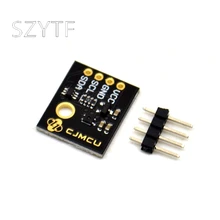In this article we look at another digital humidity sensor – this time its the SHTC1 and we will connect it to our Microbit
This is the sensor that I will be using
Lets look at the sensor
The SHTC1 is a digital humidity sensor designed especially for high-volume consumer electronics applications. This humidity sensor is strictly designed to overcome conventional limits for size, power consumption, and price-performance ratio, in order to fulfill the current and future requirements of the consumer electronics market.
Sensirion’s CMOSens® technology offers a complete sensor system on a single chip, consisting of a capacitive humidity sensor, a band-gap temperature sensor, analog and digital signal processing, A/D converter, calibration data memory, and a digital communication interface supporting I2C fast mode.
The ultra-small, 2 × 2 × 0.75 mm3 DFN package enables applications to be placed in even the most limited of spaces. The sensor covers a humidity measurement range of 0 to 100 %RH and a temperature measurement range of –30°C to 100°C with a typical accuracy of ±3 %RH and ±0.3°C.
The operating voltage of 1.8 V and an energy budget below 1 µJ per measurement make the SHTC1 suitable for mobile or wireless applications running on the lowest power budgets. With the industry-proven quality and reliability of Sensirion’s humidity sensors and constant accuracy over a large measurement range, the SHTC1 humidity sensor offers an unprecedented price-performance ratio.
Features
| Interface | I²C |
| Supply voltage | 1.8 V |
| Power consumption | 2µW (at 1 reading per second in low power mode) |
| Measuring range (RH) | 0 – 100% relative humidity |
| Measuring range (T) | -30 to +100°C (-22 to +212°F) |
| Response time (RH) | 8s (tau63%) |
Parts Required
Once again for ease of use I connect an expansion board to the microbit, I feel this makes it easier to connect to a sensor like the one pictured above using connecting wire
Schematic/Connection
| Microbit | Sensor |
| 3v3 | Vcc |
| Gnd | Gnd |
| SDA – 20 | SDA |
| SCL – 19 | SCL |
Code Example
This uses the library from https://github.com/Sensirion/arduino-sht
[codesyntax lang=”cpp”]
#include <Wire.h>
#include "SHTSensor.h"
SHTSensor sht;
// To use a specific sensor instead of probing the bus use this command:
// SHTSensor sht(SHTSensor::SHT3X);
void setup() {
// put your setup code here, to run once:
Wire.begin();
Serial.begin(9600);
delay(1000); // let serial console settle
if (sht.init()) {
Serial.print("init(): success\n");
} else {
Serial.print("init(): failed\n");
}
sht.setAccuracy(SHTSensor::SHT_ACCURACY_MEDIUM); // only supported by SHT3x
}
void loop() {
// put your main code here, to run repeatedly:
if (sht.readSample()) {
Serial.print("SHT:\n");
Serial.print(" RH: ");
Serial.print(sht.getHumidity(), 2);
Serial.print("\n");
Serial.print(" T: ");
Serial.print(sht.getTemperature(), 2);
Serial.print("\n");
} else {
Serial.print("Error in readSample()\n");
}
delay(1000);
}
[/codesyntax]
Output
Open the serial monitor and you should see something like this
SHT:
RH: 40.45
T: 23.96
SHT:
RH: 40.56
T: 23.92
SHT:
RH: 40.68
T: 23.84
SHT:
RH: 40.80
T: 23.80
Links

